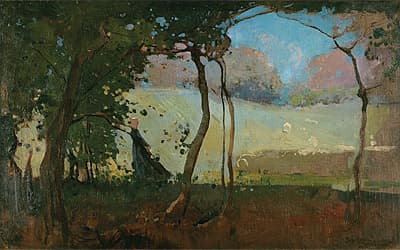
Sydney
LONG
Australia
1871
–
London
1955
England, Europe 1910-21; Australia 1921- 22; England 1922-25; Australia 1925-52; England from 1952
40.2 (h) x 65.4 (w) cm
signed and dated ‘SID LONG – 1909’ lower right New England Regional Art Museum, Armidale, gift of Howard Hinton 1939
'The voice of nature is abroad/ This night; she fills the air with balm;/ Her mystery is o’er the land;/ And who that hears her now and yields/ His being to her yearning tones,/ And seats his soul upon her wings,/ And broadens o’er the wind-swept world/ With her, will gather in the flight', wrote the English poet George Meredith, Long's favourite writer, in his poem, ‘South-west wind in the woodland’, first published in Poems (1851).
Likewise, in this painting Long depicted the Spirit of nature abroad, filling the air with balm and her mystery over the land. This shepherdess in her long, blue, flowing gown is enigmatic, mysterious; with her facial features only barely indicated, she is a phantasm as much as a person. The wind seems to rustle in the arching trees, while leaves fall to the ground. This is a simple subject, but it is not just a stylised image, it is also an allegorical one.
Long’s gentle and ethereal bush maidens, such as this shepherdess, became for him the very essence of nature — they personify its soul. His shepherdesses may seem to live a simple life minding their sheep but, more than this, they evoke the hidden Spirit of nature. They direct and care for nature and, at the same time, they become it.
'The voice of nature is abroad/ This night; she fills the air with balm;/ Her mystery is o’er the land;/ And who that hears her now and yields/ His being to her yearning tones,/ And seats his soul upon her wings,/ And broadens o’er the wind-swept world/ With her, will gather in the flight', wrote the English poet George Meredith, Long's favourite writer, in his poem, ‘South-west wind in the woodland’, first published in Poems (1851).
Likewise, in this painting Long depicted the Spirit of nature abroad, filling the air with balm and her mystery over the land. This shepherdess in her long, blue, flowing gown is enigmatic, mysterious; with her facial features only barely indicated, she is a phantasm as much as a person. The wind seems to rustle in the arching trees, while leaves fall to the ground. This is a simple subject, but it is not just a stylised image, it is also an allegorical one.
Long’s gentle and ethereal bush maidens, such as this shepherdess, became for him the very essence of nature — they personify its soul. His shepherdesses may seem to live a simple life minding their sheep but, more than this, they evoke the hidden Spirit of nature. They direct and care for nature and, at the same time, they become it.
'The voice of nature is abroad/ This night; she fills the air with balm;/ Her mystery is o’er the land;/ And who that hears her now and yields/ His being to her yearning tones,/ And seats his soul upon her wings,/ And broadens o’er the wind-swept world/ With her, will gather in the flight', wrote the English poet George Meredith, Long's favourite writer, in his poem, ‘South-west wind in the woodland’, first published in Poems (1851).
Likewise, in this painting Long depicted the Spirit of nature abroad, filling the air with balm and her mystery over the land. This shepherdess in her long, blue, flowing gown is enigmatic, mysterious; with her facial features only barely indicated, she is a phantasm as much as a person. The wind seems to rustle in the arching trees, while leaves fall to the ground. This is a simple subject, but it is not just a stylised image, it is also an allegorical one.
Long’s gentle and ethereal bush maidens, such as this shepherdess, became for him the very essence of nature — they personify its soul. His shepherdesses may seem to live a simple life minding their sheep but, more than this, they evoke the hidden Spirit of nature. They direct and care for nature and, at the same time, they become it.
